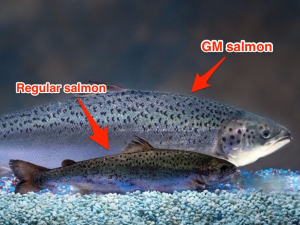The First Genetically Altered Animal Is Approved for Eating
< < Go Back
AquAdvantage grows twice as fast as regular salmon.
A salmon that has never been seen in nature but grows twice as fast as regular salmon just got closer to store shelves and restaurant menus. AquAdvantage–a patented Atlantic salmon that includes genetic material from two other fish species–has been the subject of controversy for years, but on Nov. 19, the U.S. Food and Drug Administration said its scientists had deemed it safe for humans to eat. It’s the first genetically modified animal the agency has greenlighted for human consumption. The fish will be bred in land-based tanks in Canada and Panama.
Gene-altered salmon may have trouble winning over some consumers and retailers who are wary of the potential environmental and health hazards of eating genetically modified animals. Here’s what all the fuss is about.
Is genetically modified salmon safe to eat?
The FDA says its scientists “rigorously evaluated extensive data submitted by the manufacturer, AquaBounty Technologies, and other peer-reviewed data” and determined that the salmon is safe to eat for both humans and animals. There was no difference, from a safety perspective, between eating farmed salmon and eating AquAdvantage salmon.
Will I know which salmon are genetically modified and which are not?
Not necessarily. There is no regulation in the U.S. requiring companies to label genetically modified organisms (GMOs) as such.
What other GMO foods are approved?
Most corn, soy, cotton and sugar beets–as well as some alfalfa, potatoes, papaya and other crops–that are grown in the U.S. are genetically engineered to either produce higher yields or resist pests and drought. Up to 80% of the processed foods sold in the U.S. contain GMOs.
What does gene-altered salmon taste like?
AquaBounty says it is indistinguishable from farm-raised salmon.
Why do some people oppose GMOs?
Opponents have several concerns. First, the genetic alterations could change the plant or animal in ways that could be harmful for the people who eat it. Some worry that tinkering with genes may cause changes that could damage the plant or animal by making it less fit for survival. Finally, AquAdvantage salmon are raised in containers, not in the wild, but if the new species were to make its way into rivers and oceans, for instance, some worry that it could alter the existing environment.
More From TIME Magazine:




